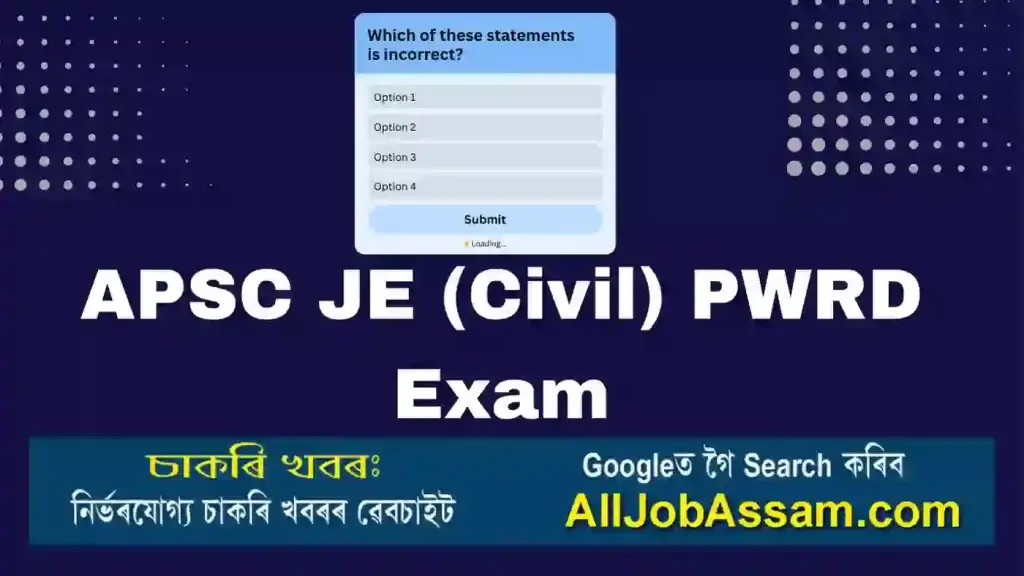APSC JE (Civil) PWRD Exam 2025: Top MCQs on Building Materials & Construction
The Assam Public Service Commission (APSC) Junior Engineer (Civil) exam under the Public Works Roads Department (PWRD) is a prestigious opportunity for civil engineering aspirants in Assam. The exam, conducted to recruit Junior Engineers for roles in infrastructure projects, includes a significant focus on Building Materials and Construction, a core subject in the syllabus. This SEO-optimized article provides essential Multiple Choice Questions (MCQs) with answers and explanations on Building Materials and Construction, tailored for the APSC JE (Civil) PWRD Exam 2025. These MCQs will help candidates enhance their preparation, test their knowledge, and improve their chances of success.
Download APSC JE (Civil) Exam eBook Click HereWhy Focus on Building Materials & Construction for APSC JE (Civil) 2025?
The Building Materials and Construction section is a critical component of the APSC JE (Civil) syllabus, testing candidates’ understanding of materials like cement, concrete, bricks, and timber, as well as construction techniques such as masonry, plastering, and damp proofing. This section typically appears in the OMR-based screening test, which consists of 200 multiple-choice questions carrying 200 marks, as per the APSC JE exam pattern. Mastering this topic is essential for scoring well and advancing to the document verification or interview stage.
Importance of MCQs in APSC JE Preparation
- Conceptual Clarity: MCQs help reinforce fundamental concepts and their practical applications.
- Exam Pattern Familiarity: Practicing MCQs familiarizes candidates with the question format and difficulty level.
- Time Management: Solving MCQs improves speed and accuracy, crucial for the time-bound exam.
- High-Weightage Topic: Building Materials and Construction questions often carry significant marks in the APSC JE (Civil) exam.
APSC JE (Civil) PWRD Exam 2025: Key MCQs on Building Materials & Construction
Below is a curated list of 10 high-quality MCQs with answers and detailed explanations to aid your preparation for the APSC JE (Civil) PWRD Exam 2025. These questions are designed to align with the syllabus and reflect the types of questions asked in previous exams.
Download APSC JE (Civil) Exam eBook Click HereConstruction Engineering MCQs
MCQ 1: Composition of Gypsum
What is the primary composition of gypsum used in construction?
Show Answer & Explanation
Answer: B) Calcium sulfate dihydrate
Gypsum is a mineral composed of calcium sulfate dihydrate (CaSO₄·2H₂O), widely used in construction for plaster, drywall, and cement additives. It consists of calcium sulfate combined with two water molecules, making it ideal for lightweight and fire-resistant applications.
MCQ 2: Ideal Water-Cement Ratio
For a concrete mix of 1:3:6 by weight with a water-cement ratio of 0.6, what is the quantity of water required per 50 kg bag of cement?
Show Answer & Explanation
Answer: C) 30 liters
The water-cement ratio is 0.6, meaning 0.6 kg of water is required per 1 kg of cement. For a 50 kg bag of cement: Water required = 0.6 × 50 = 30 kg. Since 1 kg of water equals approximately 1 liter, the answer is 30 liters.
MCQ 3: Construction Joint Placement
Where are construction joints typically provided in concrete structures?
Show Answer & Explanation
Answer: B) Within the middle third of beams and slabs
Construction joints are placed in the middle third of beams and slabs to minimize shear stress and ensure structural integrity. This positioning reduces the impact of differential stresses during concrete pouring.
MCQ 4: Compressive Strength of Bricks
What is the minimum compressive strength required for first-class bricks used in construction?
Show Answer & Explanation
Answer: C) 105 kg/cm²
First-class bricks, as per Indian standards, must have a minimum compressive strength of 105 kg/cm² to ensure durability and load-bearing capacity in construction projects.
MCQ 5: Purpose of Damp Proofing
What is the primary purpose of damp proofing in buildings?
Show Answer & Explanation
Answer: B) Prevent moisture ingress
Damp proofing is applied to walls and floors to prevent moisture penetration, which can cause structural damage and mold growth. Materials like bitumen or waterproof membranes are commonly used.
MCQ 6: Types of Masonry
Which type of masonry is most suitable for load-bearing walls?
Show Answer & Explanation
Answer: C) Both A and B
Both stone masonry and brick masonry are widely used for load-bearing walls due to their high compressive strength and durability. The choice depends on availability, cost, and design requirements.
MCQ 7: Setting Time of Cement
What is the initial setting time of ordinary Portland cement (OPC)?
Show Answer & Explanation
Answer: A) 30 minutes
The initial setting time of ordinary Portland cement is approximately 30 minutes, as per IS 4031, allowing sufficient time for mixing, transporting, and placing concrete before it begins to harden.
MCQ 8: Use of Ferro-Cement
Ferro-cement is primarily used in construction for:
Show Answer & Explanation
Answer: B) Thin, lightweight structures
Ferro-cement, made of cement mortar reinforced with wire mesh, is ideal for thin, lightweight structures like water tanks, roofing panels, and boats due to its high tensile strength and flexibility.
MCQ 9: Properties of Good Timber
Which of the following is a characteristic of good-quality timber for construction?
Show Answer & Explanation
Answer: B) Uniform color and texture
Good-quality timber should have a uniform color and texture, be free from defects like knots and cracks, and have low moisture content to ensure strength and durability.
MCQ 10: Critical Path Method (CPM)
The Critical Path Method (CPM) in construction planning is primarily used for:
Show Answer & Explanation
Answer: B) Scheduling and time management
The Critical Path Method (CPM) is a project management tool used to identify the longest sequence of tasks in a construction project, ensuring timely completion by focusing on critical activities.
MCQ 11: Fineness of Cement
The fineness of cement is tested by which of the following methods?
Show Answer & Explanation
Answer: B) Sieve analysis
The fineness of cement is determined using sieve analysis, typically with a 90-micron sieve, as per IS 4031. Finer cement particles ensure better hydration and strength development.
MCQ 12: Purpose of Admixtures
What is the primary function of admixtures in concrete?
Show Answer & Explanation
Answer: B) Modify properties of concrete
Admixtures are chemicals added to concrete to modify its properties, such as workability (plasticizers), setting time (retarders or accelerators), or durability (air-entraining agents).
MCQ 13: Types of Bonds in Brick Masonry
Which bond is most commonly used in brick masonry for residential buildings?
Show Answer & Explanation
Answer: A) English bond
The English bond, consisting of alternating courses of headers and stretchers, is widely used in residential buildings due to its strength and stability for load-bearing walls.
MCQ 14: Workability of Concrete
Which test is used to measure the workability of fresh concrete?
Show Answer & Explanation
Answer: B) Slump test
The slump test measures the workability of fresh concrete by assessing its consistency and flow. A higher slump indicates better workability, suitable for specific construction needs.
MCQ 15: Soundness of Cement
The soundness of cement is tested to ensure:
Show Answer & Explanation
Answer: B) Resistance to volume changes
The soundness test, conducted using the Le Chatelier apparatus, ensures that cement does not undergo excessive expansion due to free lime or magnesia, which could cause cracking in structures.
MCQ 16: Types of Aggregates
Which type of aggregate is most suitable for high-strength concrete?
Show Answer & Explanation
Answer: C) Angular aggregates
Angular aggregates provide better interlocking and higher bond strength with cement paste, making them ideal for high-strength concrete used in structural applications.
MCQ 17: Function of Curing
The primary purpose of curing concrete is to:
Show Answer & Explanation
Answer: B) Prevent loss of moisture
Curing maintains adequate moisture and temperature in concrete to ensure proper hydration of cement, enhancing strength and durability. Methods include water curing and membrane curing.
MCQ 18: Types of Plaster
Which type of plaster is commonly used for exterior walls to resist weathering?
Show Answer & Explanation
Answer: B) Cement plaster
Cement plaster, made from cement and sand, is durable and weather-resistant, making it suitable for exterior walls exposed to rain and temperature variations.
MCQ 19: Bulking of Sand
The bulking of sand is caused by:
Show Answer & Explanation
Answer: B) Moisture content
Bulking of sand occurs due to moisture content, which causes sand particles to stick together, increasing volume. This must be accounted for in concrete mix design.
MCQ 20: Purpose of Shuttering
Shuttering in concrete construction is used to:
Show Answer & Explanation
Answer: B) Provide temporary support and shape
Shuttering (formwork) is a temporary mold that holds fresh concrete in place until it hardens, ensuring the desired shape and structural integrity.
MCQ 21: Types of Concrete Mix
Which concrete mix is used for plain cement concrete (PCC) in foundations?
Show Answer & Explanation
Answer: B) M10
M10 concrete mix (1:3:6 ratio) is commonly used for plain cement concrete (PCC) in foundations due to its adequate strength for non-structural purposes.
MCQ 22: Fire Resistance of Materials
Which building material has the highest fire resistance?
Show Answer & Explanation
Answer: C) Concrete
Concrete has excellent fire resistance due to its low thermal conductivity and ability to withstand high temperatures without significant structural damage.
MCQ 23: Properties of Bitumen
Bitumen is primarily used in construction for:
Show Answer & Explanation
Answer: B) Waterproofing and road construction
Bitumen is a viscous material used for waterproofing (e.g., in damp-proof courses) and as a binder in road construction for asphalt pavements.
MCQ 24: Types of Foundations
Which type of foundation is most suitable for black cotton soil?
Show Answer & Explanation
Answer: C) Pile foundation
Pile foundations are ideal for black cotton soil due to its high expansiveness and low bearing capacity, as piles transfer loads to deeper, stable soil layers.
MCQ 25: Testing of Bricks
The water absorption test for bricks ensures that absorption does not exceed:
Show Answer & Explanation
Answer: C) 20%
As per Indian standards, first-class bricks should not absorb more than 20% of their weight in water after 24 hours of immersion, ensuring durability and strength.
MCQ 26: Types of Cement
Which type of cement is best suited for marine structures?
Show Answer & Explanation
Answer: C) Sulphate Resisting Cement (SRC)
Sulphate Resisting Cement (SRC) is designed to resist sulphate attacks, making it ideal for marine structures exposed to seawater.
MCQ 27: Load-Bearing Capacity of Soil
The bearing capacity of soil is primarily influenced by:
Show Answer & Explanation
Answer: B) Soil type and compaction
The bearing capacity of soil depends on its type (e.g., clay, sand) and degree of compaction, which determine its ability to support structural loads.
MCQ 28: Types of Roofs
Which type of roof is most suitable for heavy rainfall areas?
Show Answer & Explanation
Answer: B) Pitched roof
Pitched roofs have a sloping design that allows water to drain quickly, making them ideal for areas with heavy rainfall to prevent water accumulation.
MCQ 29: Purpose of Reinforcement
The primary purpose of reinforcement in concrete is to:
Show Answer & Explanation
Answer: B) Enhance tensile strength
Concrete is strong in compression but weak in tension. Reinforcement (e.g., steel bars) is added to enhance the tensile strength of concrete structures.
MCQ 30: Segregation in Concrete
Segregation in concrete occurs due to:
Show Answer & Explanation
Answer: A) Excessive water content
Segregation occurs when coarse aggregates separate from the cement paste, often due to excessive water content, leading to non-uniform concrete.
Tips for Preparing Building Materials & Construction for APSC JE (Civil) 2025
- Study Standard Textbooks: Refer to books like “Building Materials” by S.K. Duggal and “Concrete Technology” by M.S. Shetty for in-depth knowledge.
- Practice Previous Year Papers: Solve APSC JE previous year question papers to understand question patterns and difficulty levels.
- Take Mock Tests: Use platforms like Testbook or Next Engineer for mock tests to simulate exam conditions.
- Focus on High-Weightage Topics: Prioritize topics like concrete technology, masonry, and construction techniques, which are frequently tested.
- Revise Regularly: Review key concepts like material properties, testing methods, and construction practices to retain information.
Why Practice These MCQs?
Practicing these MCQs will help you:
- Understand Key Concepts: Gain clarity on material properties and construction techniques.
- Identify Weak Areas: Analyze your performance to focus on topics needing improvement.
- Boost Confidence: Familiarity with question types reduces exam-day anxiety.
- Improve Speed and Accuracy: Regular practice enhances your ability to solve questions quickly and correctly.


